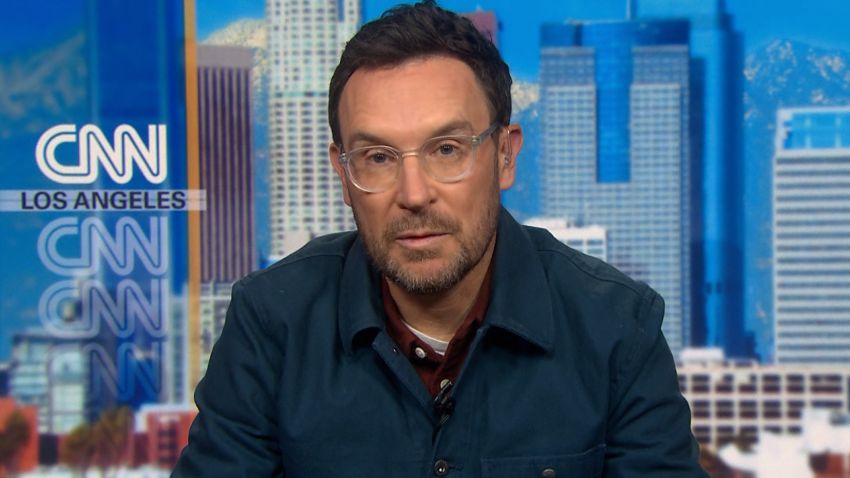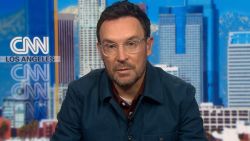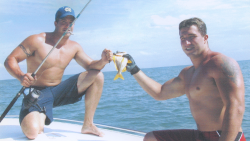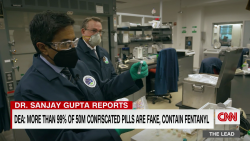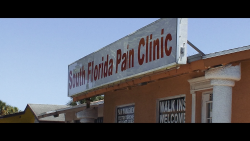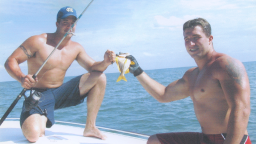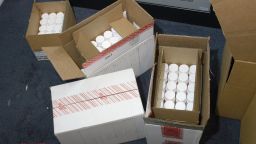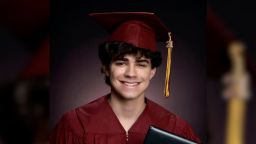A version of this story appeared in CNN’s What Matters newsletter. To get it in your inbox, sign up for free here.
Today’s headlines are about heroin and fentanyl, but there’s a remarkable new CNN documentary to remind us all that the opioid crisis has roots in the US pharmaceutical industry.
“American Pain” documents a very specific time period when a group of young men opened pain clinics in South Florida and, with the help of doctors and pharmaceutical companies, flooded the country with addictive pain medication and got rich in the process.
The film is bizarre and will leave you wondering how, exactly, this could actually have happened. It charts the rise and fall, in particular, of Chris and Jeff George, twin brothers obsessed with bodybuilding, who somehow became prescription drug kingpins.
The film also documents how authorities ultimately built legal cases against the owners of pain clinics with undercover work and help from informants who wanted to stop the pain clinics.
I talked to the director, Darren Foster, about how he came to tell this tale of absurdities.
The film was many years in the making. He first met the George brothers in 2009. He had been researching the opioid crisis in Kentucky, where a sheriff showed him pill bottles from Florida. That led him to the South Florida pain clinic.
At first, the brothers literally chased him away from the clinic. Within six months, they would be targets of the biggest prescription drug investigation in US history.
After their prosecution, Foster convinced the brothers and a surprising number of other people to take part in the film. Excerpts of our phone conversation are below.
This story is incredible. How did you get these people to open up?
WOLF: How did you get from a moment of confrontation, with the brothers chasing you down the highway, to interviewing them in prison?
FOSTER: I basically told them that I thought their story was interesting because I thought it was, on some level, an indictment of the pharmaceutical industry.
The George brothers weren’t an anomaly. There were other clinic owners. “Pill Mill Vinny” – Vincent Colangelo – who was still on probation for heroin trafficking when he opened a clinic. Zach Rose, who was 23 at the time, who was operating a grow house growing marijuana and trafficking cocaine when he opened up his first clinic.
These are the guys that the pharmaceutical industry thought it was good to partner with to distribute pills. I thought that by telling their story, it would show on some level that while these guys went to prison, the pharmaceutical industry, on some level, got away scot-free.
Doctors and pharmaceutical companies did not take part
WOLF: There are certainly no interviews with people from the pharmaceutical industry in the film. You don’t talk on camera to doctors who were involved. Was that an intentional thing, or would those people just not talk to you?
FOSTER: Yes, exactly that. When you make a film, you have to figure out what the constraints of the film are. And the constraint of this film, in my mind, was always I wanted it to be in first person for the people who either perpetrated this conspiracy or the people who were on the front lines of investigating how to bring it down.
That included, obviously, the George brothers and other clinic owners and people who worked in the clinics, and then the local law enforcement and the federal law enforcement agency agencies who were there to sort of put the case together.
Of course, I definitely wanted to interview the doctors and reached out to every doctor who was involved in “American Pain.” They all just decided that they did not want to take part in this whatsoever.
And same thing with the pharmaceutical industry, especially the pharma reps who supplied them. I reached out to several of those people who I was able to identify, and none of them wanted anything to do with the documentary.
We had the advantage that I was able to get, through a Freedom of Information request, all the wiretaps from the case, the undercover video and a lot of documents, and I think that helps illustrate the entire ecosystem that allowed these clinics to operate.
The George brothers didn’t have medical degrees. They weren’t writing prescriptions. They had a bunch of doctors who were willing to do that for them. They didn’t give any individualization of care. They broke basically the same script for everybody that walked through the door.
An absurd true story that feels like a farce
WOLF: The tone of the movie is almost farcical. It’s funny at times. Before it kicks you in the gut, it veers more toward the ludicrousness of what was happening than the sadness of it. What made you decide to go in that direction?
FOSTER: The tone of the film was something that I knew it was going to be a fine balance. What I really want to capture was the absurdity.
Looking back a decade on, it is obviously absurd. Even at the time, it was absurd. Everybody who was there at the time, including myself, knew this was crazy, what was happening.
From local citizens who saw people lining up outside the clinics, who were picking up needles in their front yard, who were seeing people fighting in parking lots, supposedly medical establishments. To law enforcement who were pulling people over, responding to overdoses at local motels all the time. Everybody knew that this was absurd.
The only people who didn’t seem to want to raise a red flag about it were the pharmaceutical industry. They actually have a legal obligation to report to the DEA when they suspect that something suspicious is happening with their controlled substances. But at no point did any of them ever raise a red flag.
Instead they kept on supplying people like the George brothers and a bunch of other clinics. At one point there were hundreds of clinics that sprouted up between Broward and Palm Beach County. I wanted to catch the tone of just how absurd it was.
The people who were running the clinics, they were in their 20s, they were having a good time, they were making a lot of money. I wanted to put people on that ride.
I wanted people to understand how you could get swept up in this when you realize that you’ve hit on the greatest drug racket since the “Cocaine Cowboys,” with all the money that implies. You get swept up in it.
At some point in the film, I was gonna pull the rug and you’re gonna understand the consequences of this. That people all along the way were getting addicted, and it was a huge tragedy unfolding.
Zach Rose says in the film that he was blinded to what was happening. The money blinded him to how bad things were. He knew people were dying. He knew people that were going to his clinic are dying. But the money blinded him.
I think that’s what happened to a lot of people. They just got blinded by the money. And they ultimately just didn’t care about consequences.
How the opioid crisis has evolved
WOLF: I also wrote that down when Zach Rose said that. He said, “The doctors turned a blind eye, the owners turned a blind eye, the pharmacists, the distributors and everyone lined their pockets.”
The pain clinics have been shut down, right? How has this evolved in the years since the events of the film?
FOSTER: The film doesn’t actually end on a hopeful note. There is not a pretty little bow at the end that says we shut down the clinics and then everything returns to normal, because unfortunately, that is the tragedy of the opioid crisis.
Once they shut down the pain clinics, unfortunately, there was a huge population of people who were already addicted to opioids. When they couldn’t find the pills, they had to find another source to sustain their habit, and that’s when heroin came in. You had people transitioning from pills to heroin, which was cheaper and even more potent.
And now you have the next evolution, this sort of third wave of assault, which is fentanyl, which has been devastating over these last few years – especially since the pandemic, with the overdose rates skyrocketing.
Why was Florida the key to this?
WOLF: Your reporting in Appalachia led you down to Florida. How did everything spread from Florida?
FOSTER: The opioid crisis gained its foothold first in Appalachia and some pockets in the Northeast – but then with Florida, it basically turned into a national problem, because you had this pipeline that extended between Florida and Appalachia, and then Florida and the Northeast, and then everywhere in between.
These pills were so ubiquitous that law enforcement dubbed I-95 and I-75 the Blue Highway or the Oxy Express, because there were just so many pills coming out of Florida, up and down the East Coast, with people coming from even farther away than that.
Was there accountability?
WOLF: One of the things that I found kind of amazing is that everybody except for one character has been to jail and been released. These are major drug dealers, essentially, but most of what they were doing was, by the letter, legal. It almost feels like a slap on the wrist even though these guys spent years in jail.
FOSTER: Chris George, Jeff George and a lot of the other players were some of the first people to be prosecuted for prescription drug trafficking at this level. The prosecutors on the case and the FBI really had to figure it out. How do you prosecute a case like this when you’re dealing with something that is technically a “legal” drug.
Unlike heroin or cocaine, which are illegal across the board, it is not as easy to make a case against people, doctors, clinic owners, when the drug that they’re distributing is a legal pharmaceutical.
These guys are spending quite a bit of time in prison. I don’t think any of them are happy about the fact that they’ve spent the majority of their adult lives behind bars.
But when you look at some of the others – the doctors got off. The pharmaceutical companies – no one has been criminally charged for what happened in Florida.
I would say that these guys kind of got left holding the bag. They definitely deserved what they got, but they were pretty much the ones that were held to account.
Local reporters deserve a lot of credit
WOLF: What am I missing?
FOSTER: Things wouldn’t have changed in Florida without the attention of local reporters like Carmel Cafiero and Anthony Pineda, who were really hammering this story and are in the film. I think it’s a testament to the importance of local journalism, local reporting, because they were the ones who identified the craziness and started making big investigations into it before anybody.
I think it was because of their persistence that people realized they had to start taking this seriously – and they ultimately forced changes in Florida to shut down the pain clinics.


